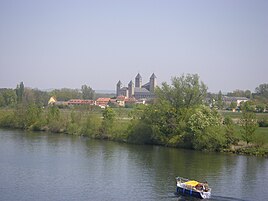Münsterschwarzach
|
Münsterschwarzach
|
|
|---|---|
| Coordinates: 49 ° 48 ′ 18 ″ N , 10 ° 13 ′ 56 ″ E | |
| Height : | 198 m |
| Area : | 83 ha |
| Residents : | 590 (2017) |
| Population density : | 711 inhabitants / km² |
| Incorporation : | 1st October 1973 |
| Postal code : | 97359 |
| Area code : | 09324 |
|
Location of Münsterschwarzach (bold) within the Schwarzach municipality
|
|
|
The center of Münsterschwarzach: The monastery of the same name
|
|
Münsterschwarzach is a district of the market Schwarzach am Main in the Lower Franconian district of Kitzingen .
Geographical location
Münsterschwarzach connects to Schwarzach am Main to the north and lies on the banks of the Main and on the KT 29 district road that runs through the town . It leads north to Gerlachshausen and the St 2271 and south to Stadtschwarzach .
The B 22 and the A 3 run south of Münsterschwarzach in an east-west direction .
Münsterschwarzach is naturally located in the so-called Schwarzacher valley widening (also Schwarzacher basin). It is a basin-like river valley widening that is formed by the Schwarzach, Castellbach and Silberbach tributaries of the Main. It is part of the Middle Main valley of the main unit Mainfränkische Platten .
The Franconian Marienweg runs through Münsterschwarzach .
history
Shortly after the Münsterschwarzach Abbey was founded in 742, the area was settled. The founding of the abbey goes back to the founders Megingaud and Imma, who founded a male monastery in the Steigerwald ( Megingaudshausen Monastery ). At the same time, a nuns' convention was set up in today's Schwarzach as a care institute for the Mattonen's second daughters . In the 9th century the nuns moved to Zurich and the monks from the Steigerwald took over the monastery.
The monastery was initially a royal monastery and was awarded to the Bishop of Würzburg in 933 . The abbots managed to build up a fairly large monastery area. During the German Peasants 'War , the abbey was plundered by the citizens of the neighboring town of Schwarzach and destroyed several times during the Thirty Years' War . In the course of secularization, the abbey was dissolved and Münsterschwarzach became part of the Gerlachshausen community, with which it had been connected since 1348.
The monastery village did not become independent until 1864. On October 1, 1973, Münsterschwarzach became part of Schwarzach am Main as part of the municipal reform.
coat of arms
| Blazon : "In silver over three lowered, narrow, blue wavy bars a continuous red bridge with two arches, floating above the capital letter M." | |
| Reasons for the coat of arms: The floating “M” refers to the importance of the monastery (Latin: Monasterium) Münsterschwarzach for the history of the place. The bridge, on the other hand, is a reference to the Main crossing, which has connected Münsterschwarzach with Schwarzenau on the other side of the Main since 1890. The wavy lines symbolize the Main river. |
Attractions
The center of the cultural monuments in Münsterschwarzach is the Benedictine abbey site, which has been settled again since 1913. The abbey is dominated by the four- tower monastery church , which was built between 1935 and 1938 according to plans by the architect Albert Boßlet . It is already the fourth church building in the same place after a Carolingian , Romanesque and Baroque church by Balthasar Neumann did not survive the time. Only Neumann's monastery mill was preserved.
In addition to several workshops, the Vier-Türme-Verlag and a center for adult education, the Egbert-Gymnasium Münsterschwarzach has settled on the area of the abbey .
Some architectural monuments have been preserved in the village. The half-timbered house of the old monastery restaurant Zum Benediktiner was built in the 17th century. The arch bridge over the Schwarzach was rebuilt around 1680. There are some wayside shrines and small memorials in the village. The crucifixion shrine was built in front of the monastery in 1475 , the so-called Christoffel shrine was erected next to the bridge in 1607.
Personalities
- Jodokus Jäcklein († March 8, 1560), abbot of Aura Monastery on the Saale (1557–1560), monk of Münsterschwarzach
- Plazidus Reich (born as Johann Christoph Reich, 1695–1764), abbot of the Neustadt am Main monastery
- Georg Joseph Lorenz Beringer (1745–1807), professor in Bamberg, cathedral vicar in Würzburg, specialist writer
- Johannes Mahr (* 1941), literary scholar, taught at Egbert-Gymnasium from 1979 to 2006
The heads of the Benedictine monastery are also closely connected to Münsterschwarzach:
literature
- Hans Bauer: Old and new coats of arms in the Kitzingen district . In: Yearbook of the district of Kitzingen 1980. In the spell of the Schwanberg . Kitzingen 1980. pp. 53-70.
- Hans Bauer: District of Kitzingen. An art and culture guide . Market wide 1993.
- Johann Ludwig Klarmann: The Steigerwald in the past. A contribution to Franconian cultural studies . Gerolzhofen 2 1909.
- Johannes Mahr: Münsterschwarzach - 1200 years of a Franconian abbey (= Münsterschwarzacher studies, vol. 49) . Münsterschwarzach 2002.
- Mission Benedictines of Münsterschwarzach (ed.): Benedictine Abbey of Münsterschwarzach . Münsterschwarzach 2011.
Web links
Individual evidence
- ↑ Schwarzach am Main: Münsterschwarzach , accessed on February 8, 2017.
- ^ Bauer, Hans: District of Kitzingen . P. 40.
- ^ Bauer, Hans: Old and new coats of arms in the district of Kitzingen . P. 66.
- ↑ See: Missions Benedictines of Münsterschwarzach (ed.): Benedictine Abbey Münsterschwarzach .
- ^ Heinrich Wagner: The list of documents of the Aura Monastery on the Saale from 1556 . In Theobald Freudenberger, Klaus Witt City (ed.): Würzburg Diocesan Geschichtsblätter 47. Vol . Würzburg 1985. p. 117.
- ↑ Klarmann, Johann Ludwig: The Steigerwald in the past . P. 204.




